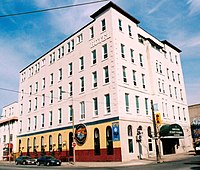
St. Catharines is the largest city in Canada's Niagara Region and the sixth largest urban area in the province of Ontario. As of 2016, it has an area of 96.13 square kilometres (37.12 sq mi), 136,803 residents, and a metropolitan population of 406,074. It lies in Southern Ontario, 51 kilometres (32 mi) south of Toronto across Lake Ontario, and is 19 kilometres (12 mi) inland from the international boundary with the United States along the Niagara River. It is the northern entrance of the Welland Canal. Residents of St. Catharines are known as St. Catharinites. St. Catharines carries the official nickname "The Garden City" due to its 1,000 acres (4 km2) of parks, gardens, and trails.
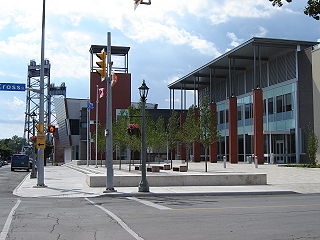
Welland is a city in the Regional Municipality of Niagara in Southern Ontario, Canada. As of 2021, it had a population of 55,750.
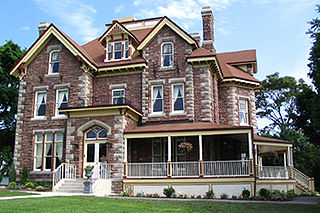
Thorold is a city in Ontario, Canada, located on the Niagara Escarpment. It is also the seat of the Regional Municipality of Niagara. The Welland Canal passes through the city, featuring lock 7 and the Twin Flight Locks.
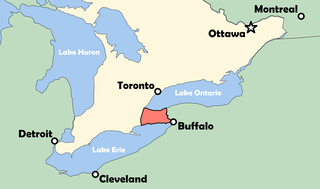
The Niagara Peninsula is an area of land lying between the southwestern shore of Lake Ontario and the northeastern shore of Lake Erie, in Ontario, Canada. Technically an isthmus rather than a peninsula, it stretches from the Niagara River in the east to Hamilton, Ontario, in the west. The peninsula is located in the Golden Horseshoe region of Southern Ontario, and has a population of roughly 1,000,000 residents. The region directly across the Niagara River and Lake Erie in New York State is known as the Niagara Frontier.

The Regional Municipality of Niagara, also colloquially known as the Niagara Region or Region of Niagara, is a regional municipality comprising twelve municipalities of Southern Ontario, Canada. The regional seat is in Thorold. It is the southern end of the Golden Horseshoe, the largest megalopolis in Canada.
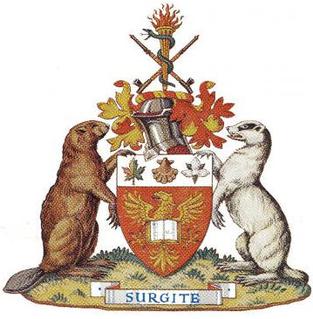
Brock University is a public research university in St. Catharines, Ontario, Canada. It is the only university in Canada in a UNESCO Biosphere Reserve, at the centre of Canada's Niagara Peninsula on the Niagara Escarpment. The university bears the name of Maj.-General Sir Isaac Brock, who was responsible for defending Upper Canada against the United States during the War of 1812.
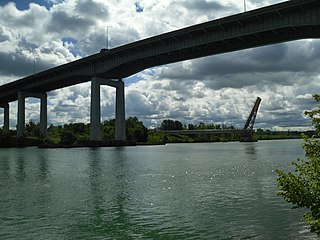
The Garden City Skyway is a major high-level bridge located in St. Catharines and Niagara-on-the-Lake, Ontario, Canada, that allows the Queen Elizabeth Way (QEW) to cross the Welland Canal without the interruption of a lift bridge. Six lanes of traffic are carried across the bridge, which is 2.2 kilometres (1.4 mi) in length and 40 metres (130 ft) at its tallest point.

Merritton is both a distinct community within and a council ward of St. Catharines, Ontario, Canada. It was named after William Hamilton Merritt, a prominent local entrepreneur and founder of the Welland Canal Company. Until 1858, Merritton was named Welland City, but exchanged names that year with Merrittsville, when that town became the "seat" of Welland county.

The Diocese of Niagara is one of thirty regional divisions in the Anglican Church of Canada. The see city of the diocese is Hamilton, with the bishop's cathedra located at Christ's Church Cathedral on James Street North. Located within the ecclesiastical province of Ontario, it borders the Dioceses of Huron and Toronto. The area enclosed by the Diocese of Niagara includes much of the Golden Horseshoe, and moves north to include Erin and Orangeville as far as Shelburne. Moving sharply south the line includes Mount Forest and widens, south-westerly to include Elora and Guelph. Skirting Brantford and the Territory of the Six Nations Confederacy, the line then travels, again, south-westerly to Jarvis and Lake Erie to include the entire Niagara Peninsula. Major urban centres within its borders are St. Catharines, Niagara Falls, Hamilton, Guelph, Oakville, Milton, Burlington, and Orangeville.

The Welland House Hotel was a historic building located on 26-30 Ontario Street in Downtown St. Catharines, Ontario, Canada. The hotel spa resort was one of many in Upper Canada during the Victorian era. It closed in 1993. As of 2020, the site was in the process of being designated as a heritage site to prevent future demolition. Its last use was as a student residence, and then sat vacant. On July 12, 2021; it was destroyed in an early morning fire.

Canal Days is a marine heritage festival held in Port Colborne, Ontario, Canada. The festival has been held annually since it was started in 1979 by the Port Colborne Historical & Marine Museum.
Brian James McMullan was the mayor of St. Catharines, Ontario, Canada from 2006 to 2014. He was elected to the position in the 2006 St. Catharines municipal election. He was previously a St. Catharines city councillor and a Niagara regional councillor.

St. Catharines Transit (SCT) was a public transit agency which provided bus services to St. Catharines, Ontario, and the neighbouring city of Thorold. The St. Catharines Transit Commission took over operation of transit services within the city from Canadian National Transportation in 1961. In January 2023, St. Catharines Transit was merged with Niagara Falls Transit and Welland Transit to form a single regional transit service, Niagara Region Transit
Welland Transit was a public transportation agency in Welland, Ontario, Canada from 1977 to 2022. Upon its inception in 1973 the bus service was operated by a private company, known as "Metro Niagara Transit," funded by the city of Welland, which assumed full operation of the transit system in 1977. On January 1st, 2023, it was merged with St. Catharines Transit and Niagara Falls Transit to form Niagara Region Transit.
Elections were held in the Niagara Region of Ontario on October 25, 2010 in conjunction with municipal elections across the province.

The Meridian Centre is a 5,300 seat arena in downtown St. Catharines, Ontario, Canada, located at 1 David S. Howes Way. The arena is the home of the Niagara IceDogs of the Ontario Hockey League and the Niagara River Lions of the Canadian Elite Basketball League.

Grimsby GO Station is a proposed commuter rail station on the GO Transit train and bus network in Southern Ontario, Canada. Located in the town of Grimsby in the Regional Municipality of Niagara, it would be a stop on the Lakeshore West line, east of the proposed Confederation GO Station in Hamilton. It was expected to open in 2021 and would have been the first station to open in the planned Niagara extension, which will also include stops at St. Catharines and Niagara Falls stations.

The Burgoyne Bridge is a bridge in St. Catharines, Ontario, Canada. The original bridge was built in 1915 by the Dominion Steel and Coal Corporation. In 2010, construction of a new Burgoyne Bridge was recommended by the Niagara Region. However, the project was not completed until 2016 due to the estimated cost. The new bridge is 333 meters long and features a 125-metre main span supported by a steel arch.
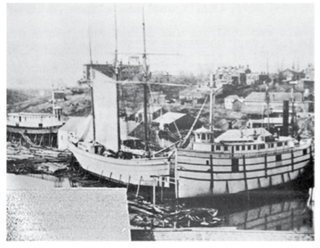
The Shickluna Shipyard was a shipyard that was crucial to the early history of Downtown St. Catharines.

